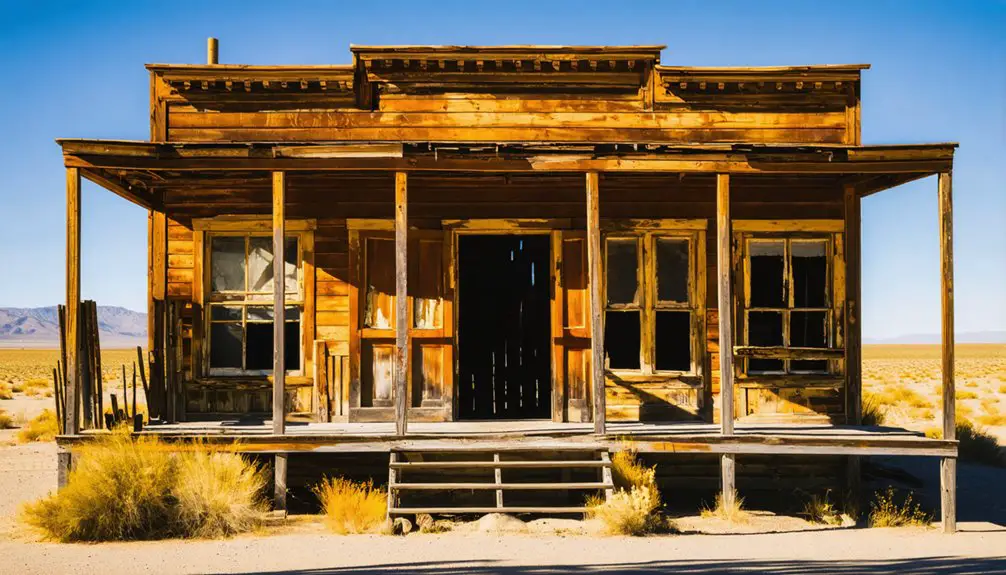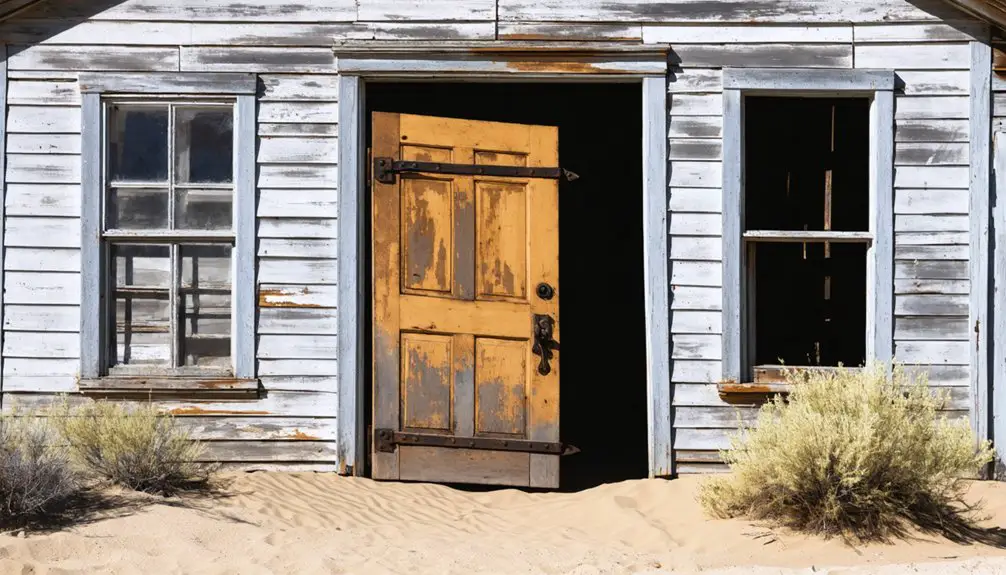You’ll find Henry’s ghost town origins in Nevada’s railroad history, established in 1868 along the first Transcontinental Railroad as a water stop. The settlement grew considerably after 1904’s gold and silver discoveries, becoming renamed Bellehelen by 1906. The town flourished with grocery stores, saloons, and gaming tables along Main Street, while the Oregon Short Line depot served as an essential cattle shipping hub. Today’s weathered ruins and mining artifacts reveal deeper layers of Western frontier life.
Key Takeaways
- Henry emerged in 1904 following gold and silver discoveries, initially named Bellehelen, developing from a railroad settlement into a bustling mining town.
- The town’s growth was driven by the Oregon Short Line railroad depot, which served as a vital hub for cattle transport.
- Main Street featured grocery stores, saloons, and gaming tables by 1907, reflecting the town’s rapid development during its peak.
- The site contains weathered ruins and partially standing structures, including mining artifacts that showcase early 20th-century technological advancements.
- Henry’s transformation from railroad stop to mining boomtown exemplifies Nevada’s dynamic frontier settlement patterns and eventual ghost town status.
Origins of a Railroad Settlement
While the First Transcontinental Railroad carved its path across Nevada in 1868, Henry emerged as one of many settlements that dotted the Central Pacific’s eastward route from Sacramento.
Following the natural pathways of river valleys, railroad engineering teams tackled challenging terrain, including the narrow Palisade Canyon near Carlin. You’ll find Henry’s location was strategically chosen to support steam locomotives that required frequent water stops and maintenance. The federal government issued 6 percent interest bonds to finance such railroad construction projects.
Steam locomotives demanded strategic water stops along their journey, making Henry’s location near Palisade Canyon an engineering necessity.
Like many railroad towns of the era, Henry likely began as a “Hell on Wheels” settlement of tents and temporary structures housing workers and support services. Freight and passenger services through towns like Henry helped transport goods and people at one-tenth the cost of traditional stagecoach travel.
The site transformed into a permanent stop, serving as an essential link in the railroad’s infrastructure. Chinese laborers and other workers established camps nearby as they laid track at record-breaking speeds, while businesses sprouted up to serve the growing community.
The Legacy of Henry Harris
Three remarkable achievements defined Henry Harris’s legacy in Nevada: his rise from a cook for Governor John Sparks to a respected ranch foreman, his groundbreaking leadership of mainly white ranch hands at the D.B. Ranch, and his lasting cultural impact on the region’s ranching heritage.
The Oregon Short Line depot became vital for local cattle operations before its closure in 1978.
Like the stamp mills that once processed precious ore in the area, Harris’s leadership transcended racial barriers of the era, earning him recognition for his fair-mindedness, bronc busting skills, and storytelling abilities.
Harris’s influence preserved in the naming of Henry station in 1925, which served as a crucial hub for cattle shipping and local ranch families.
His pioneering role hasn’t been forgotten – he’s now enshrined in both the Buckaroo Hall of Fame and the National Cowboys of Color Hall of Fame, cementing his place as a significant figure in Western African American history.
Life Along the Oregon Short Line
As the Oregon Short Line pushed southward into Nevada in the early 1900s, it sparked an intense railroad competition that would reshape the region’s transportation landscape.
You’d have witnessed fierce battles between OSL and the Clark brothers, as their grading teams raced through Meadow Valley wash, leading to both physical confrontations and legal disputes.
Railroad history shows how this competition transformed into cooperation when Harriman’s OSL acquired half of Clark’s railroad, allowing the Salt Lake Route to be completed and later absorbed into the Union Pacific system.
The railway’s presence sparked community development along its route, with towns like Henry springing up to serve the railroad’s needs. The area’s rail development eventually influenced the construction of the Nevada Short Line in 1913, adding another vital transportation link to the region. Like other narrow gauge lines of the era, it used a three foot width to reduce construction expenses.
Mining and ranching operations flourished with the new freight connections, though some communities that were bypassed struggled to survive.
Ranching and Railway Operations
You’ll find that Henry’s Oregon Short Line depot served as a critical hub where local ranchers efficiently transported their cattle via rail starting in 1925.
Like the nearby city of Metropolis, the area faced challenges from devastating rabbit infestations that threatened local agricultural operations.
The station’s water tower and pump system maintained steam locomotive operations while simultaneously supporting nearby ranch operations with essential water resources.
Henry Harris, an influential African American foreman who managed regional cattle operations in the 1920s, exemplified the close partnership between ranchers and railway personnel that kept the local economy thriving.
The railway line helped establish Henry as a vital metropolitan hub for the surrounding agricultural region, connecting remote ranches to larger markets and distribution networks.
Cattle Transport Logistics
During the late 1800s, cattle transport around Henry, Nevada involved two major logistics systems: traditional overland cattle drives and emerging railway operations.
You’d find seasoned cowboys implementing careful cattle handling techniques as they moved herds across challenging Sierra Nevada terrain toward the Comstock mining region. Many ranchers like Hooker gained experience by driving to Carson City, making the challenging trek multiple times to sell their cattle. After witnessing his success transporting 10,000 Texas Longhorns to Arizona in 1872, other ranchers adopted similar large-scale transport methods.
Logistical planning was essential to prevent losses. You couldn’t just wing it – drives required precise coordination of feed, water, and rest stops. The timing had to account for weather patterns, avoiding harsh winters that could decimate herds.
Once you reached railway hubs like Carson City, you’d load your cattle into specialized stock cars for efficient delivery to distant markets. This combination of overland drives and rail transport helped ranchers like Henry Clay Hooker capitalize on premium beef prices in mining communities.
Water Stop Operations
While steam locomotives powered the growth of Nevada’s railway network, Henry’s water stop proved indispensable for both train operations and regional ranching activities. The water supply system, established around 1925, featured a strategically positioned water tower and pump station next to the depot, enabling efficient servicing of passing trains.
You’ll find these critical operational features of Henry’s water stop:
- Elevated water towers provided gravity-fed filling for quick locomotive servicing
- Pumping facilities maintained water reserves despite the region’s arid conditions
- Regular maintenance guaranteed uninterrupted service for steam locomotives every 7-10 miles
- The stop supported both railway schedules and livestock transport needs
The facility’s reliable water supply kept trains running through Nevada’s challenging landscape until diesel engines eventually replaced steam power, leading to the stop’s closure.
Rancher-Railway Partnerships
As Nevada’s railway system expanded across the frontier, ranchers and railroad companies formed crucial economic partnerships that transformed the state’s agricultural landscape.
You’ll find that these relationships flourished particularly after the discovery of the Comstock Lode, which created unprecedented demand for local food supplies.
The ranching economics near Henry benefited tremendously from rail infrastructure, as the new transportation network slashed shipping times and reduced livestock weight loss compared to traditional cattle drives.
Thanks to the 1862 Homestead Act, ranchers could claim land near rail stops, creating efficient shipping points for their cattle and agricultural goods.
Small depot towns emerged as critical links between ranchers and distant markets, while narrow gauge railways connected remote ranching communities to larger transportation networks, ensuring their economic survival in Nevada’s competitive marketplace.
A Town’s Rise and Decline
Once gold and silver were discovered in Nevada’s Silverbow Mining District in 1904, the town of Henry quickly emerged from the desert landscape.
Originally plotted in 1906 and renamed Bellehelen, the town’s community dynamics transformed rapidly as prospectors rushed to stake their claims.
You’ll find evidence of dramatic economic shifts throughout the town’s brief but vibrant history.
- By 1907, you’d have seen a bustling Main Street with grocery stores, saloons, and gaming tables.
- Mining operations peaked in 1909-1910, extracting $500,000 in precious metals.
- The town’s revival in 1917 brought a new surge of activity and hope.
- Between 1923-1927, sporadic operation of the cyanide mill marked the town’s final chapter.
Historical Significance in Nevada

Because of its role in Nevada’s mining heritage, Henry-Bellehelen stands as a quintessential example of early 20th-century boom towns that shaped the state’s development.
You’ll find its story intertwined with the broader pattern of mining camps that defined Nevada’s economic landscape during this era. The town’s evolution from its 1904 origins showcases the remarkable impact of mineral discoveries on regional growth.
Between 1909 and 1910, the town’s mines produced an impressive $500,000 in gold and silver, while its industrial infrastructure, including a 20-stamp mill and later a cyanide mill, demonstrated technological advancement.
Like many of its neighboring communities, Henry-Bellehelen’s economic impact extended beyond mere mineral extraction, creating a hub for commerce and community life until operations ceased in 1927.
What Remains Today
Today’s visitors to Henry-Bellehelen encounter a landscape dotted with weathered ruins and partially standing structures that tell the story of its mining past.
The harsh desert climate and isolation have challenged ruins preservation efforts, leaving mostly stone foundations and deteriorating walls where a bustling mining community once stood.
Among the archaeological findings, you’ll discover:
- The Tom Kelly bottle house, constructed from over 50,000 recycled glass bottles
- Remnants of miners’ union halls and old schoolhouses
- The historic Moffett House ruins and rock shop remains
- Scattered mining artifacts and colored cinder blocks known as “Lady Desert”
You’ll need to navigate carefully through the site, as many structures are unstable.
While less preserved than other Nevada ghost towns, Henry’s fragments offer a raw glimpse into the state’s mining heritage.
Frequently Asked Questions
What Happened to Henry Harris After the Town Was Named After Him?
After Henry’s legacy was honored in the town’s name, Harris tended the O’Neal ranch’s Cottonwood pasture, suffered declining health near San Jena, Idaho, and passed away in 1937, cementing Harris’ impact.
Were There Any Significant Accidents or Disasters at Henry’s Railroad Station?
You won’t find records of any significant railroad accidents or station disasters at Henry’s stop. While the region saw rail incidents, including the 1939 City of San Francisco derailment nearby, Henry’s station remained incident-free.
How Many People Lived in Henry During Its Peak Population Years?
You’ll find that Henry’s peak population growth and town demographics weren’t precisely documented, but based on similar mining towns in Esmeralda County, it likely reached between several hundred to 2,000 residents.
Did Henry Have Any Hotels or Lodging Facilities for Railroad Travelers?
Swift as a desert wind, you won’t find any hotels in Henry’s history. The small railroad depot lacked traveler amenities, serving mainly as a water station without formal railroad accommodations.
What Native American Tribes Originally Inhabited the Area Around Henry?
You’ll find that Native tribes like the Washoe, Northern Paiute, and Shoshone originally inhabited this region, with the Washoe having particular cultural significance through their pine nut gathering and seasonal settlements nearby.
References
- https://www.youtube.com/watch?v=opD2zxGhNtg
- https://nvtami.com/2024/03/03/mesquite-presidents-weekend-trip-to-mesquite/
- http://lastadventurer.com/last-adventurers-fieldnotes/2012/9/5/rhyolite-nevada-ghost-town-or-ghost-town
- https://en.wikipedia.org/wiki/Aurora
- https://www.nvexpeditions.com/elko/henry.php
- https://en.wikipedia.org/wiki/First_transcontinental_railroad
- https://shpo.nv.gov/uploads/documents/McBride_-_Exploration_and_Early_Settlement_in_NV
- https://billofrightsinstitute.org/essays/the-transcontinental-railroad
- https://en.wikipedia.org/wiki/History_of_the_Union_Pacific_Railroad
- http://cprr.org/Museum/Ephemera/RIC_Rail_1864.html



